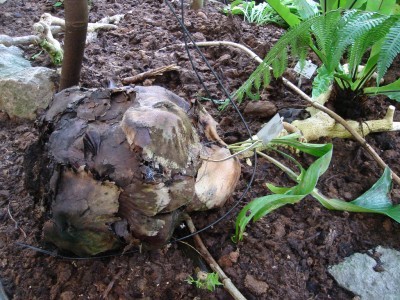






While many people have both heard of and dealt with root rot in houseplants, most are not aware that this disease can also have an adverse effect on garden plants outdoors, including shrubs and trees. Learning more about the cause of root rot and how to look for early signs of root rot in garden plants will go a long way in its treatment. For root rot prevention and treatment info, keep reading.
Root rot is a disease that attacks the roots of plants growing in wet soil. Since the disease spreads through the soil, the only root rot remedy for garden plants is often to remove and destroy the plant. However, you can try these corrective measures if you want to attempt to save a particularly valuable plant:
The cause of root rot is a fungus. Species of the Pythium, Phytophthora, Rhizoctonia, or Fusarium fungi are the usual culprits. These fungi thrive in wet soil, and you can transfer them from one part of the garden to another when you transplant ailing plants.
When it comes to identifying root rot, look at the plants. Plants with root rot can’t absorb moisture and nourishment from the soil properly. The plants often resemble those suffering from drought and stress and mineral deficiencies.
Signs of root rot in garden plants include stunting, wilting and discolored leaves. Foliage and shoots die back and the entire plant soon dies. If you pull up a plant with root rot, you will see that the roots are brown and soft instead of firm and white.
Trees with root rot develop cankers, ooze reddish or black sap, and sometimes develop dark vertical streaks.
The best root rot remedy for garden plants is prevention. Prevent root rot by filling in low parts of the garden and improving the soil with organic matter so that it drains freely. If you can’t improve the drainage, use raised beds where the where plant roots sit above the soil. Taking care not to overwater garden plants will also help.
There are chemical fungicides and biological agents labeled as treatment for root rot disease; however, you should not use these products unless you know which fungus is causing the problem. Contact your local agricultural extension agent for information about how to have the fungus identified.
Once you know which fungus you are treating, your agricultural extension agent can recommend a product to treat that specific fungus. Fungicides are toxic chemicals that should be used with caution. Read the label and follow the instructions exactly. Store them in their original container and out of the reach of children.
Even when all of the precautions are taken in the garden, root rot may still occasionally become an issue. However, if you pay attention to the signs of root rot in garden plants, you’ll have a better chance of saving your plants.
Copyright © www.100flowers.win Botanic Garden All Rights Reserved